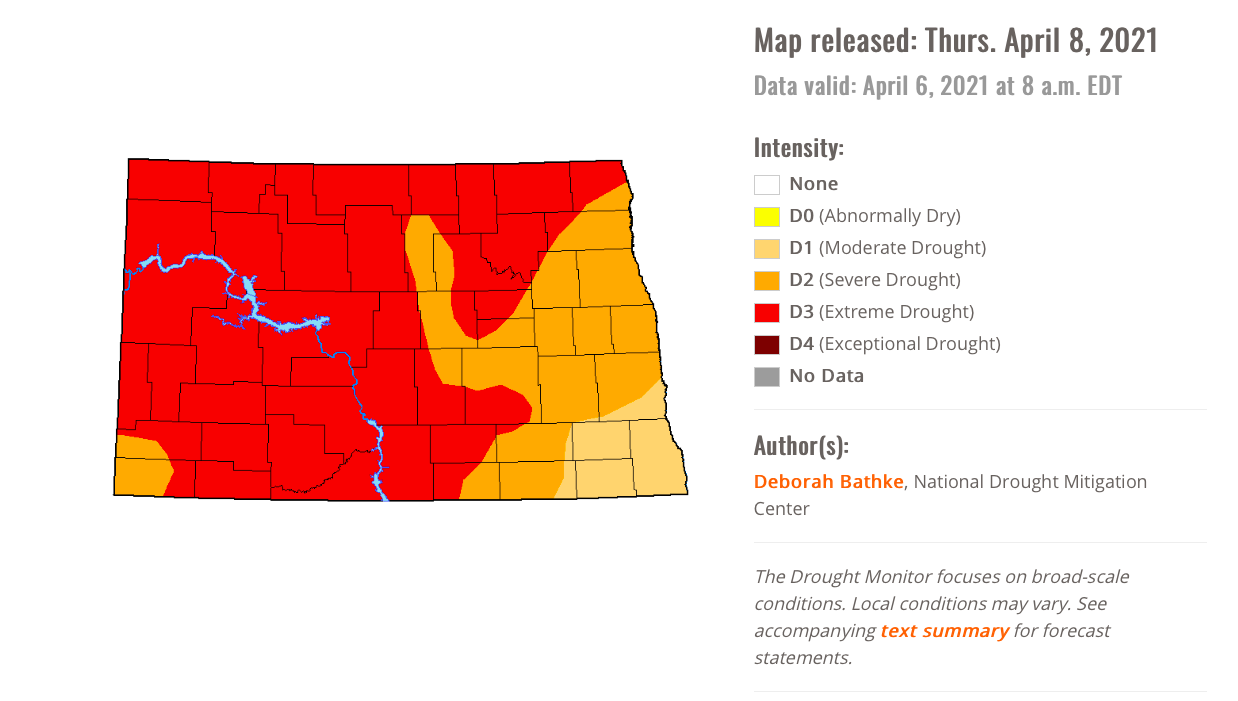Parking Planters and Culling Cows: Early, Harsh Realities of North Dakota’s Growing Drought
Drought Conditions Grow 040921
North Dakota just endured its driest September to March ever on record, and the scars are starting to show. On Thursday, Governor Doug Burgum declared a state of emergency due to drought.
Thursday’s U.S. Drought Monitor showed while the entire state is experiencing dryness, 94% of the state is in the D3, or severe drought, which was a a 24-point jump in just a week.

The dryness is already impacting planting decisions. USDA shows 92% of North Dakota's topsoil is rated short to very short of moisture. With growing concerns about the lack of moisture, farmers are debating parking the planter for now.

"It's terribly dry,” says Kim Saueressig, a farmer in McCluskey, N.D. “We started seeding two days ago into some durum wheat stubble from last year, and hilltops were bone dry.”
Saueressig says the ground is so dry it’s almost like concrete, making it nearly impossible to plant.
“Yesterday, we just started seeding some durum wheat into pinto bean ground from last year, and it's 10 times worse," he adds. “I would have never thought that it would have been as dry as it is. As farmers, we’re eternal optimists, but when you have air seeders set for 2.5 to 3 inches deep to try to get it down to moisture with no till drills, and you have down pressure set up as high as you can get it, and you can only maybe get an inch into the ground, because it's just concrete out there. One pass with the air seeder and it's just powder behind it.”
https://t.co/qclCFMz40B
This is from yesterday. Thinking of parking them too — Kim Saueressig (@SaueressigKim) April 8, 2021
Culling Cows
The U.S. Drought Monitor this week also revealed the drought is so severe in the western portion of the state that ranchers are already making the tough decision to destock livestock by culling cows.
“We're at a point right now where they're just starting to make their decisions,” says Larry Schnell, partner and manager of Stockmen's Livestock Exchange in Dickinson, N.D.“Today's sale day, and so we've sold about 100 head of red cows, and then starting next week, we'll start seeing cow-calf pairs. Most people around here are not done calving yet. So once they're done calving, then we'll see these cow-calf pairs come to town, and it will be a pile of them.”
Schnell says based on conversations he’s already having, once calving season wraps up in the state, more cows will be culled by cattle producers making drastic decisions based on drought.
“I mean, most people are considering a minimum of 25% of the herd,” he says. “Some of them are talking 50%. In western North Dakota, we've really not seen any rain of any substantial amount since September 2019.”
Schnell says hay costs are climbing, and with pastures lacking moisture to become lush for feed, it’s a situation many North Dakota producers won’t be able to escape unless it rains.
“Pastures are terrible,” he adds. “It isn't even greening up, and we've had probably the mildest winter we've had for a long, long time. If we had any moisture at all, our grass would be very lush right now because of the temperatures that we've had. But it's not even greening up; anything that's here is from last year. And most people left their cattle out on grass longer than normal, because of the fact that the weather was so nice. So even that, even if they did have some left, most of that is gone.“
Schnell says due to ongoing dryness, hay stocks are also low. And while more tough decisions will weigh on North Dakota cattle producers, some are already making the decision to cull cows due to drought.
“On our sale today, we'll probably end up with about 4,200 cattle, and if it was a normal sale today, we'd had maybe 3,000,” says Schnell. “We've got like 700 cows and bulls today, which is very abnormal. Usually, we won't see that until after calving. So, there are those who are starting to move sooner, but once we get into May, we've got a cow-calf pairs special scheduled for the first week of May. We'll probably be selling pairs every week, and we might have to go to two days a week. We'll sell 1000s of pairs if this continues.”
Never thought we would see this but parked both drills tonight because it’s too dry to get above 85% ground contact with @PrecisionPlant #SeederForce not to mention NH3 won’t seal and we can’t keep good ride over 80% in tall canola stubble . Needs to rain soon #ND @OfficialRFDTV pic.twitter.com/f3HwxzzPEi — Travis P. Messer (@travismesser81) April 8, 2021
From ranchers to farmers weighing row-crop decisions, Saueressig says farmers have a little time to make final decisions, but are hopeful a little moisture will help them get the 2021 crop in the ground.
“It’s only April 8 right now, so we're probably three weeks ahead of schedule,” he says. “We're still going to keep on seeding. We did cut back fertilizer rates, though, just to keep the costs down. If we do get the rains, we can always emerge-apply, but there are more guys that I think are going to start planting this week. And keep on going, there will be a lot of decisions to be made. I don't think anybody knows what to do.”
Related Stories:
North Dakota Farmers Need 200% of Normal Spring Rainfall to Undo Drought







